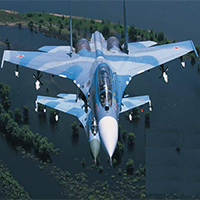With Brahmos-fitted Su-30, IAF reaches new high

With the successful test flight on Saturday of a Sukhoi-30MKI fighter fitted with a Brahmos cruise missile, the Indian Air Force (IAF) has moved closer to a potent new capability.
When the Indo-Russian Brahmos is operationalised on the Su-30MKI, IAF pilots would no longer have to fly deep into heavily-defended airspace to strike enemy fighter bases, or targets like terrorist camps, nuclear installations and military headquarters. Instead, they can launch a Brahmos from as far away as 295 kilometres, and turn back to safety while the missile flies on to do the destruction.
Business Standard learns the IAF will modify at least 40 Su-30MKI fighters to carry the Brahmos missile.
Air-launched land-attack missiles are not new, nor are cruise missiles like the vaunted US Tomahawk missile, that can be launched from thousands of kilometres away. What makes the Brahmos-Su-30MKI combination lethal is the speed with which it strikes – the aircraft flies well above Mach 2, and the missile flies at Mach 2.8, giving enemy air defences little chance to detect and shoot them down before they strike the target.
Besides eliminating the need for taking a human pilot over heavily defended targets, the Brahmos has also proven to be a highly accurate missile. For the IAF, getting Hindustan Aeronautics Ltd (HAL) – which builds the Su-30MKI under licence at Nashik – to integrate the aircraft with missile has been a priority.
On instructions from Air Headquarters, Sukhoi (in Russia) and HAL (in India) independently conducted feasibility studies. After the IAF determined that HAL had evolved the simpler, most manageable, design, it placed an order on HAL in January 2014 to integrate the Brahmos onto the Su-30MKI.
“It is a perfect example of ‘Make in India’ and an engineering marvel in aviation history of India. It proves that when all agencies come together with one mission, there is nothing like impossible,” declared the HAL chief, T Suvarna Raju, after the flight test today.
Business Standard was granted exclusive access to the Brahmos upgrade, while HAL was carrying it out at a facility called the Aircraft Upgrade R&D Centre (AURDC) in Nashik.
The AURDC had earlier upgraded the MiG-27 and MiG-21 fighters, partnering a Defence R&D Organisation (DRDO) laboratory called the Defence Avionics Research Agency (DARE). Along with DARE, the Indian Institute of Technology, Mumbai, also played a part in the Brahmos upgrade.
A key challenge was to strengthen the Su-30MKI airframe, particularly its underbelly weapons station, to carry the huge Brahmos missile (8 metres long, 0.7 metres in diameter, and 2560 kg in weight).
Read More http://www.business-standard.com